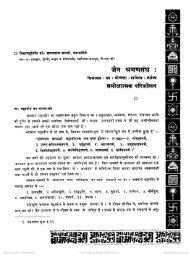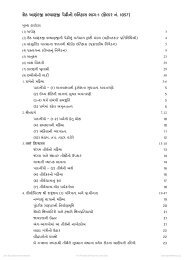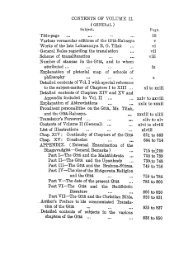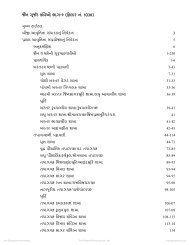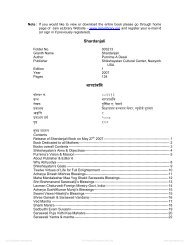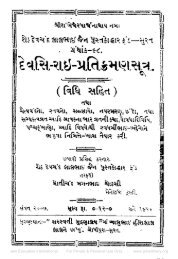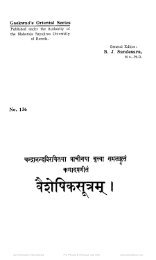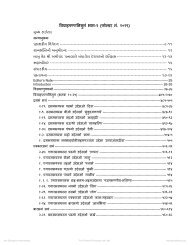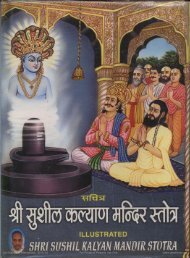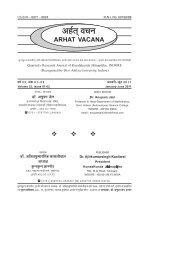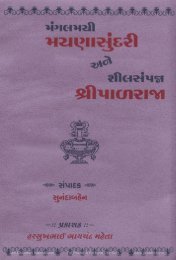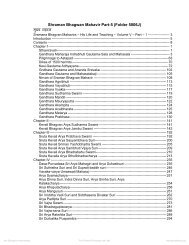Exposition Of Pratikramana Stotras
Exposition Of Pratikramana Stotras
Exposition Of Pratikramana Stotras
Create successful ePaper yourself
Turn your PDF publications into a flip-book with our unique Google optimized e-Paper software.
<strong>Exposition</strong><strong>Of</strong><strong>Pratikramana</strong><strong>Stotras</strong>ByRati Dodhia
<strong>Exposition</strong><strong>Of</strong><strong>Pratikramana</strong> StotraTranslation and explanation of <strong>Pratikramana</strong> <strong>Stotras</strong> in EnglishByRati Dodhia
<strong>Exposition</strong> of <strong>Pratikramana</strong> <strong>Stotras</strong>By Rati DodhiaFirst Edition: 2009 A.D© All rights reserved by author. However the material in the bookmay be used for educational purpose or in case of quotationsembodied in books, articles and reviews.Front cover designed by Rati DodhiaCopy edited by Dr. Vimal Prakash JainTypesetting by Pranay JainCumberland, RIPrinting sponsored byMadhu and Hemendra Raichand ShahDeborah and Venilal Hansraj SumariaLalji Khimji Dodhia FamilyPrinted by:M/s. Uchitha Graphic Printer Pvt. Ltd.,65, Ideal Ind. Estate, Lower Parel, Mumbai 4001 013
DEDICATIONIn memory of our beloved motherLate Shrimati Hiraben Raichandbhai ShahHemendra and Shah FamilyIn memory of our beloved motherLate Shrimati Kankuben Hansraj Sumaria ShahVeni and Sumaria FamilyThis book is also dedicated to all the emancipators seeking theright path to ultimate release.
viMy profound gratitude to my friend Dr.Vimal Prakash Jain, retiredprofessor of Jaina Literature of University of Jabalpur at Jabalpur ,Madhya Pradesh India for editing the manuscript and offeringmany valuable suggestions and comments.I am thankful to my niece and nephew Jyotsna and Sudhir Shah forencouragement and support whenever I needed and my friendPranay Jain for showing lot of patient and help in preparing thismanuscript ready for printing.I am also very thankful to my friend Satish Shah for many valuablesuggestions and comments.The stotras and the prayers of <strong>Pratikramana</strong> are not easy totranslate as many times there are no equivalent words in English.But I have tried my best to keep the translation as true to thecontext as possible. In view of this if I have unknowinglymisinterpreted the meaning I ask for the forgiveness of the readersand if they have right suggestion to let me know which I caninclude in any future editions (micchami dukkadam).Rati Dodhia12 Mitris Blvd.Lincoln RI 02865, USA
Table of Contents28. Ichchhämi thämi Sutra .......................................................... 4629. Nänammi Sutra ..................................................................... 4730. Suguru Vandana Sutra ......................................................... 5031. Devasiam Äloum Sutra ......................................................... 5232. Säta Läkha Sutra ................................................................... 5333. Adhära Päpasthänaka Sutra ................................................... 5534. Vandittu Sutra ....................................................................... 5735. Äyaria Uvajjhäe Sutra ........................................................... 7036. Sua Devayä Stuti................................................................... 7137. Kshetra Devatä Ni Stuti ........................................................ 7138. Kamala Dala Stuti ................................................................. 7239. Namostu Varddhamänäya Sutra ............................................ 7240. Vishäla Lochana Sutra .......................................................... 7441. Varakanaka Sutra .................................................................. 7542. Shri Bhavana Devatä Stuti .................................................... 7543. Kshetra Devatä Stuti ............................................................. 7644. Addhäijjesu Sutra.................................................................. 7645. Laghu Shänti Stava Sutra ...................................................... 7746. Chaukkasäya Sutra ................................................................ 8247. Mannaha Jinänam Sajjhäya Sutra .......................................... 8248. Bharahesara Sajjhäya ............................................................ 8449. Sakala tirtha Vandanä Sutra .................................................. 87Refrences .................................................................................... 92
IntroductionThe pious Jaina householder is expected to perform following sixnecessary duties every day, these are:1. Sämäyika: Practice of unbroken meditative equanimity of thesoul. The word sämäyika is derived from sama, which means wellbalanced. The one who attains equanimity of mind is free fromattachment and aversion. It helps in cleansing and enhancing theconduct attribute (chäritra guna) by acquiring right faith andknowledge. The sämäyika vow is introductory stage to Jainareligious practice of abstinence.2. Chaturvimashati Stava: Eulogy to 24 Tirthankaras. It helps incleansing; enhancing and purifying the faith attribute (darshanaguna).3. Vandanaka: Veneration to an ascetic or the congregation ofmonks. It helps in cleansing and enhancing the knowledge attribute(jnäna guna).4. <strong>Pratikramana</strong>: Practice of confession and expiation(atonement) of the past misdeeds by recitation of sacred hymns.The word pratikramana means to proceed towards purity bygradually freeing oneself from the harmful activities. According tosome authority pratikramana is further classified into 5 differentkinds: a) freeing from the sin (äsavadärapadikkamana), b) gettingrid of ignorance (michchhättapadikamana), c) getting rid of fourpassions (kashäyapadikkamana), d) stepping out of improperthoughts, words and deeds (yogapadikkamane) and e) stepping outof the states of existence (bhävapadikkamane).There are 8 different steps in pratikramana, which a person goesthrough, these are:A. <strong>Pratikramana</strong>: To confessB. Praticharana: To practice restraint
2 <strong>Exposition</strong> of <strong>Pratikramana</strong> <strong>Stotras</strong>C. Pratiharana: To be vigilant to protect the right conduct.D. Varana: To keep control over the senses.E. Nivrutti: To retreat withinF. Nindä: To reprehend one-self for any improper actions.G. Grahä: To reprehend in front of a monk or a spiritual teacher.H. Shuddhi: To cleanse by atonement or by performing penances.5. Pratyäkhyäna: Practice of self-denial by recitation of hymns toward off future faults. It is a gradual process of renunciation. Thefulfillment of 5 major vows and lesser vows, practice of spiritualvows of self discipline (guna vrata) and self mortification (shikshävrata) all fall within the scope of pratyäkhyäna. It helps incleansing and enhancing the austerity and inner strength(tapächära and viryächära).6. Käyotsarga: Rite of abandonment of body for improper deeds(atichära) for a limited time. A person who practices thekäyotsarga is required to keep his mind, body and speech underperfect restraint. From time point of view it is concerned with thepresent. It helps in cleansing and enhancing the inner strength(viryächära).“Atitam padikkamämi, paduppannam samvaremi, anägayampachchkkhämi.” I step out of past (pratikramana), I practice selfrestraintwith regard to the present (käyotsarga); I practiceabstinence with regards to future (pratyäkhyäna).The purpose of performing the pratikramana is to eradicate theeffects of past misdeeds, while the purpose of practicingpratyäkhyäna is to stop possibility of committing sins in future andthe purpose of atoning by käyotsarga is to cleanse the sins ofpresent time. All these six essential duties should be carefullystudied and systematically practiced with the intention of clearingthe path of progress of an aspirant towards the attainment ofemancipation.
<strong>Exposition</strong> of <strong>Pratikramana</strong> <strong>Stotras</strong> 3By practicing these six essential duties one cleanses and enhancesthe five categories of ethical behavior (ächära).Important points to remember while performing dailyEssential duties:1. Pronounce each word with clarity and never try to rush.2. Recite each prayer, hymn and Stotra in a soft melodious voice.1. Namukkäro SuttamObject: Deepest salutations to the five most auspicious beings.Sutra and Meaning:h’8
4 <strong>Exposition</strong> of <strong>Pratikramana</strong> <strong>Stotras</strong>sentences in Navakara Mantra. The first seven padas each has aseparate meaning while last two padas together have one meaning,thus for nine padas there are eight meanings (sampada). There are68 whole letters in the original Prakrit version of the NavakaraMantra.These are the five supreme beings (parmeshthis), who are reveredin this Mantra.Arihanta: Siddha is the highest stage of bliss even above the stateof Arihanta but in the Navakara Mantra, obeisance is offered firstto Arihanta because they are perfect worldly souls, builders of theford of righteousness, establishers of the four fold order of theJaina community and they devote their lives in preaching andguiding other living beings to the path of liberation. Lord Arihantahas 12 attributes; which are made up of 8 auspicious symbols(pratihärya) and 4 extra ordinary powers (atishaya).Twelve attributes of Arihanta are as follows:1. Jnänätishaya: Omniscience, the perfect knowledge of past,present and future of the entire Universe at the same time.2. Apäyäpagamätishaya: Lord Arihanta is free from all the faultsand where ever he travels there is absence of all natural calamitiesand diseases within the area of 125 Yojanas (1 Yojana equals 4miles) surrounding him.3. Pujätishaya: All celestial beings and humans either worship orhave desire to worship Lord Arihanta.4. Vachanätishaya: The speech of Lord Arihanta is „The Reality‟itself and well understood by celestial beings, humans and animalsin their own mode of expression (native tongue) and has 35 specialqualities.5. Ashoka Vruksha: Where a divine assembly hall is built, a treecalled Ashoka Vruksha, twelve times larger than the body of LordArihanta, is created by celestial beings. Lord Arihanta delivers hisuniversal sermon sitting under this tree. Over Ashoka Vruksha,there is another tree called Chaitya Vruksha. It is under this
<strong>Exposition</strong> of <strong>Pratikramana</strong> <strong>Stotras</strong> 5Chaitya Vruksha lord Arihanta acquires perfect knowledge(Kevaljnäna).6. Sura-pushpa vrushti: Shower of fragrant flowers by celestialbeings.7. Divya dhvani: The discourse of Lord Arihanta is accompaniedby divine music in the background played by celestial beings.8. Chämara: whisk9. Sinhänsana: A divine golden throne studded with preciousdiamonds10. Bhämandala: Halo behind the head of Tirthankara11.Devadudumbhi: The celestial beings play the musicalinstruments during the samovsharana.12. Chhatra: Divine three-tiered parasol above Tirthankara‟s head.<strong>Of</strong> the above 12, 1 to 4 is extraordinary powers (atishaya) and 5 to12 are symbols (prätihärya).Siddha: Siddhas are liberated souls and are absolutely free fromthe cycles of birth and death forever. The liberated souls live in anabode called Siddha-shilä located at the top of the universe. LordSiddha has 8 attributes.8 attributes of Siddhas are as follows:1. Ananta-jnäna: Infinite knowledge due to destruction ofknowledge obscuring (jnänävarniya) karma2. Ananta Darshana: Infinite perception due to destruction ofperception obscuring (darshanävarniya) karma.3. Avyäbädha-sukha: Eternal bliss due to destruction of feelingproducing (vedniya) karma.4. Ananta-chäritra: Perfect conduct due to destruction of deluding(mohaniya) karma.5. Akshaya-sthiti: Imperishable state due to destruction of agedetermining (äyu) karma.
6 <strong>Exposition</strong> of <strong>Pratikramana</strong> <strong>Stotras</strong>6. Arupitva: Formlessness due to destruction of name determining(näma) karma.7. Aguru-Laghutva: Not to heavy, not to light, a balancedimmaterial form due to destruction of class determining (gore)karma.8. Ananta-virya: Infinite energy due to destruction of energyrestrictor (virya antaräya) karma.Ächärya: Head of monastic congregation. Ächärya has 36attributes. For a detailed discussion of Ächärya see the sutranumber 2 page 7.Upädhyäya: Ascetic preceptor. Upädhyäya has 25 attributes.25 attributes of Upädhyäya are as follows:Mastery of 11 Anga Ägamas, 12 Upanga Agamas, 1 Charanasittari(Text which deals in code of conduct) and 1 karanasittari. (Text,which deals in performing rituals and activities).Sädhus and Sädhvis: Monks and nuns who have taken vows ofpoverty (dikshä). Sädhus have 27 attributes.27 attributes of Sädhus and Sädhvis are as follows:Observe strictly five major vows (5)Do not eat before sunrise and after sunset (6)Give protection to six categories of living beings (chha käyä jivas),i.e. one to five sensed living beings. (7-12)Keep control on pleasures derived from any of the five senses (13-17)Avoid greed (18)Forgive others (19)Keep clear conscious (20)Honest in dealing with personal clothes (21)Practice five-fold vigilance (samiti) and three-fold self-control(gupti) (22)Keep control over mental faculties (23)
<strong>Exposition</strong> of <strong>Pratikramana</strong> <strong>Stotras</strong> 7Keep control over speech (24)Keep control over physical actions (25)Endure hardships (26)Endure calamities (27)In total there are 108 attributes of 5 supreme beings (Paramesthi)2. Panchindiya SutraGuru Sthäpanä SutraObject: Recitation of 36 attributes of head of congregation.Sutra and Meaning:j02t02f#b0x\a8, sn hx2xnl0;t6\e42À1g\8, tK2xnqb1#’4Q8, Y
8 <strong>Exposition</strong> of <strong>Pratikramana</strong> <strong>Stotras</strong>rituals. Any religious activity, especially Sämäyika and<strong>Pratikramana</strong>, are most beneficial when performed in the presenceof an ascetic teacher. When it is not possible to have the presenceof an ascetic teacher, a holy book, preferably containing NavakaraMantra, Panchindiya Sutra, a religious symbol or a picture of anascetic teacher can be placed on a wooden stand at a certain height(between the nose and the navel), as a symbolic representation ofthe ascetic preceptor.It is very important to keep the image of spiritual master in mindwhile performing the rituals; otherwise performing religiousactivities is fruitless and does not produce true beneficial effects.Ächärya: Ächärya is the spiritual head of the monasticcongregation (monastic order, Sangha). Ächärya has following 36attributes:Control over pleasures and pains of the five-sense organs. The fivesense organs are; skin (touch), tongue (taste), nose (smell), eyes(sight) and ears (hearing).The categories of each sense are:1. Eight types of touches: cold, warm, soft, hard, large/heavy,small/light, smooth and rough.2. Five types of tastes: hot, bitter, rusty, sour and sweet.3. Two types of odors: pleasant and foul.4. Five types of colors: black, green, red, yellow and white,and5. Three types of hearings: live (sachitta), through somemedia (achitta) and mixed (misra).Nine ways prescribed to observe total celibacy are:a. One should not stay where there are women, animals andeunuchs, b. One should not talk to women in a passionate manner,c. a man should occupy seat previously occupied by a woman aftera minimum of 48 minutes (2 ghadi) and a woman should wait for 9hours (3 prahar) before occupying a seat previously occupied by a
<strong>Exposition</strong> of <strong>Pratikramana</strong> <strong>Stotras</strong> 9man, d. One should not look at woman with insinuating glances, e.One should not sit close to a wall where couples are sleeping orengaged in passionate conversation, f. One should not rememberprevious passionate encounters, g. One should not eat tasty orintoxicating food, h. One should not overeat and i. One should notadorn the body in any way.Free from four passions (Kashäyas): Kashäya means passion.Kasha means worldly existence, aya means profit. That whichpromotes the worldly existence is kashäya. The four types ofpassions are: Anger (krodha), pride (mäna), deceit (mäyä) andgreed (lobha). These four passions are the worst enemies to aperson‟s spiritual advancement.Observes strictly the five greater vows:1. Nonviolence (Pränatipäta Viramana Mahävrata): Totalnonviolence, in thoughts, words, and deeds2. Truthfulness (Mrushäväda Viramana Mahävrata): Alwaysspeak complete truth.3. Non-stealing (Adattädäna Viramana Mahävrata): Take onlythose things, which are duly given4. Celibacy (Maithuna Viramana Mahävrata): Observe totalcelibacy.5. Non-possessiveness (Parigraha Viramana Mahävrata): Possessonly bare necessities like clothing and vessels to accept alms.(Sädhus of Digambar sects do not wear any clothes because theyconsider clothes also as possessions).Practice of five categories of ethical behaviors (panchächära):1. Ethical behavior pertaining to right knowledge(Jnänächära): To study and teach religious scriptures, to write andencourage others to write and publish religious scriptures and, totake proper and due care of religious books is Jnänächära.
10 <strong>Exposition</strong> of <strong>Pratikramana</strong> <strong>Stotras</strong>2. Ethical behavior pertaining to right faith (Darshanächära):To understand the preaching of Jina beyond any doubts. Respectand honor Jina and the path of liberation shown by Jina.3. Ethical behavior pertaining to right conduct (Chariträchära):To observe right conduct, encourage and help other monks to dothe same.4. Ethical behavior pertaining to austerities (Tapächära): Toobserve austerities and encourage and help others observeausterities. There are two types of austerities; external austerities(Bähya tapa), which are related to voluntary endurance ofhardships and restrictions of bodily pleasures and internalausterities (Abhyantara Tapa), which directly affect the karmasand help, shed karmas.External austerities (Bähya Tapa) are: Fasting (Anashana), partialfasting (Unodari), limiting number of food items for consumption(Vrutti-Sankshepa), avoiding or limiting consumption of tastyfoods (Rasa-tyäga), voluntary endurance of physical hardships(Käyä klesha) and controlling and limiting other pleasures(Pratisanlinata)Internal austerities (Abhyantara Tapa) are: Repentance for mental,verbal, and physical wrong deeds (Präyashchitta), humility(Vinaya), selfless service to Sädhu, Sädhvi, and elders(Vaiavachcha), study of religious scriptures (Swädhyaya),meditation (Dhyäna) and abandonment of material things andpassions (Vyutsarga).5. Ethical behavior pertaining to mental, verbal, and physicalabilities or strength (Viryächära): To use mental, verbal, andphysical abilities properly and constantly engage in spiritualactivities without a moment of laziness.The path of five-fold vigilance (Samiti): These are carefulness inwalking (Iryä Samiti), talking (Bhäshä Samiti), eating (EshanäSamiti), putting down any objects like clothing, pots and pans etc.
<strong>Exposition</strong> of <strong>Pratikramana</strong> <strong>Stotras</strong> 11(Ädäna-Bhanada-Matta- Nikshepanä Samiti) and disposal ofbodily discharges (Parshthä Panikä Samiti)The path of three folds self-control (gupti): These includerefraining from all the harmful activities of thoughts (Mano Gupti),speech (Vachana Gupti) and body (Käyä Gupti).Summary of 36 attributes:Control over five-sense organs 5Observance of celibacy in nine ways 9Free from four passions 4The above 18 are observed by giving up all harmful activities(tyäga swarup).Commitment to five major vowsObservation of five categories of ethical behavior 5Carefulness in five activities 5 andRestrain of thought, speech, and bodily activities 3The remaining 18 are observed by taking up restraints (Swikarswarup).3. Khamäsamana SutraPanchänga Pranipäta SutraObject: To pay respect to god and the spiritual master.Sutra and meaning:YTy12’ w’1ba8/ x02fK0 U1x2aUU1
12 <strong>Exposition</strong> of <strong>Pratikramana</strong> <strong>Stotras</strong>respect one bows down touching five body parts; the head, bothhands and knees on the ground, it is also called PanchängaPränipata Sutra.4. Ichchhakära sutraObject: To enquire about the welfare of the spiritual master duringhis journey on the path of righteousness.Sutra and Meaning:YTyq1\/ b4n\1Y? b4nf6x2b? b4ws1j? c\3\ 2h\1l1g b4w b0u’ U1Á11,2hxºn8 y8>? Bx1’3/ c1s1 y6 >? ;1s j1a3h8 z1; f6U8>.ichchhäkära! suha räi? suha-devasi? sukha tapa? Shariraniräbädha? sukha sanjama jäträ nirvaho chho ji? swämi! sätächhe ji? bhät päni no läbha dejo jiOh! Master! I hope and wish you were comfortable during nightand day and while performing austerity, keeping in good healthand following the path of righteousness. Oh master are you inpeace? Will you please do me favor and accept the alms?Explanation: Spiritual preceptor (guru) in Jain religion is definedas one who rejects the mundane existence and follows the path ofliberation.What is importance of spiritual preceptor?If we look into past every great person had a preceptor (guru) forproper guidance. Without his guidance it is not possible to achieveanything. Always respect him, serve him to best of your ability andask his permission and act according to his instruction to start anyreligious activity.
<strong>Exposition</strong> of <strong>Pratikramana</strong> <strong>Stotras</strong> 135. Abbhutthio SutraGurukhämanä SutraObject: Asking forgiveness from the spiritual master.Sutra and Meaning:YTy1q1\6a b02fbn ;exh¹/
14 <strong>Exposition</strong> of <strong>Pratikramana</strong> <strong>Stotras</strong>Explanation: This sutra shows respect and feelings to the spiritualmaster by a householder who wishes to confess for all theforbidden things he may have done and all the duties that he mayhave not performed, all the violations of the twelve vows, all theoffences against right faith, knowledge and conduct, all evils as aresult of possessions, all actions motivated by passions and hate,partiality for false creeds and dissemination of false dogmas, andall wrong done in course of daily business or household duties.6. Shri Iriyävahiyam-Airyäpathiki SutraIriyävahiyä SutamObject: Asking forgiveness for the injuries caused to all livingbeings while moving around.Sutra and Meaning:YTy1q1\6a b02fbn ;exh¹/ Y2\#1x2n#0 j2[Q’12’? YTy0, YTy12’j2[Q2’K0. !Y2\#1x2n#1
<strong>Exposition</strong> of <strong>Pratikramana</strong> <strong>Stotras</strong> 15contains water bodies (apa-käyas) and earth bodies (prithvikäyas)},and on cobwebs. 3-4u6 ‘6 >x1 2x\12n#1. %
16 <strong>Exposition</strong> of <strong>Pratikramana</strong> <strong>Stotras</strong>Making an additional effort, to repent, to cleanse the soul byextracting evil out of myself, I stand in body-abandonment posture(Käyotsarga).Explanation: Reciting the iriyävahiyam sutra will purify theimpure soul; but some sins may still persist, which are destroyedby reciting the tassa uttari sutra.Our soul is pierced with sins, to extract the sins out we have toperform the following acts: Make additional efforts, repent andreproach and resort to path of three spiritual jewels. To perform theabove-mentioned activities, it is important to perform the bodyabandonmentposture (Käyotsarga).Uttarikarana means act of additional effort; präyaschitkaranameans act of confession by repentance and reproach;vishodhikarana means act of resorting to the path of right faith,knowledge and conduct (the three spiritual jewels) to prevent anyfurther perverted attitudes and acts by evilness. Vishalyikaranameans eliminating the sins from the soul forever by performing allthe above activities so that they can never return.It is very important to perform all religious ceremonies with pureand clear conscious, this is achieved by performing a form ofmeditation in which a person abandons his body and concentrateson the soul (käyotsarga).If a person performs atonement (pratikramana) with pureintentions, not only he can get rid of all the sins committed duringthat day but also his karmic bonds of many past births are alsodestroyed. Laghu <strong>Pratikramana</strong> means short <strong>Pratikramana</strong>.
<strong>Exposition</strong> of <strong>Pratikramana</strong> <strong>Stotras</strong> 178. Shri Annattha – Ägära SutraKäussaggasutamObject: Description of the pledges, exceptions, and time limitduring body-abandonment posture (käyotsarga).Sutra and Meaning:
18 <strong>Exposition</strong> of <strong>Pratikramana</strong> <strong>Stotras</strong>That which purifies the mind. (Präyas means that which is ingeneral, chitta means purifies the mind).The other involuntary movements, which are major exceptions,are: a. When one has to move from one‟s place and posture due tonatural calamities like fire, lightening, earth quakes and others, b.to save a living creature e.g., mouse from claws of a cat, c. becauseof unexpected attack by robbers or molestation by wild animalslike snake bites and others, or d. forced to move by order of higherauthority.Thus, there are 12 minor exceptions and 4 major interruptions ofKäyotsarga.Käyotsarga: The word „Käyotsarga‟ is the Sanskrit translation ofthe Prakrit word „Käussagga‟. It means the undisturbedabandonment of the body. It is defined as standing in silent inmeditation motionless except the involuntary movements of thebody such as breathing, for a fixed duration until the Namokäramantra is recited by loudly saying “Namo Arihantänam.”Käyotsarga may be performed either with <strong>Pratikramana</strong> or for thesake of mastery over oneself, i.e. victory over calamities.The duration of Käyotsarga is specified in terms of respiratorycycles. One respiratory cycle equals one deep breath in and onedeep breath out. Concentrating on breathing cycles helps achievedeep concentration necessary for meditation. The most commonduration of Käyotsarga is 25 respiratory cycles.Käyotsarga should be done without committing any of thefollowing 19 errors:Standing either on one leg or keeping the leg in a crooked position(ghotakadosha), taking support of a pole or wall while sitting(stambahädosha), touching the ceiling with head (mäladosha),keeping feet apart (nigaddosha), sitting with toes or heels touchingeach other (uddhidosha), keeping hands on the private parts(shabaridosha), holding the whisk in a wrong position(khalinadosha), keeping head bowed down (vadhudosha), coveringthe navel area and area below the knees with a cloth(lambottaradosha) , covering the chest (for man only)
<strong>Exposition</strong> of <strong>Pratikramana</strong> <strong>Stotras</strong> 19(stanadosha) , counting the time period of Käyotsarga by fingersor by movements of eyelids (bhamuhangulidosha) , moving theeyeballs like a crow (väyasadosha) , moving the head side ways(shira:kampa dosha) , making (hun-hun) noise like a dumb person(mukadosha), speaking incoherently like a drunk (madirädosha),making movements like a monkey (prekshyadosha) , hidingclothes soiled by perspiration (kapitthadosha), swaying the body(latädosha) and covering the whole body (sayantidosha).Women are allowed to keep down the head, cover the chest, thelegs and the whole body.9. Logassa SutraNämastava SutraObject: Eulogy of 24 Tirthankaras of Bhärata Kshetra of thepresent cycle.Sutra and Meaning:z8eBb KUU8
20 <strong>Exposition</strong> of <strong>Pratikramana</strong> <strong>Stotras</strong>I bow to Pushpadanta (Suvidhinätha), Shitalnätha, Shreyansnätha,Vasupujya, Vimalnätha, Anantnätha, Dharamnätha andShäntinätha. 3q40d40
<strong>Exposition</strong> of <strong>Pratikramana</strong> <strong>Stotras</strong> 21duties prescribed in Jaina texts, which a householder traditionallyperforms in morning and evening everyday. These necessary duties(ävashyaka) are: 1.Sämäyika-practice of meditation. 2.Chaturvimshati Stava-praise of 24 Tirthankaras. 3. Vandanäpayingrespect to monks. 4. <strong>Pratikramana</strong>-Atonement by recitationof the set form of prayers for confession of faults committed in thepast. 5. Käyotsarga-the rite of abandonment of the body for limitedtime. And 6. Pratyäkhyäna-Renouncement by recitation of the setform of prayers for fending of future faults, generally expressed inthe form of dietetic restrictions like fasting etc.Rushabhdeva invented the fire, method of warfare, divided thesociety into different groups on the basis of their profession andvarious arts.10. Karemi Bhante SutraPachchkkhäna SutraObject: To achieve natural state of asceticismSutra and Meaning:q\62’ ;0s6/ b1’1Y#0, b1xUu0 U8e0 jTtq¹w12’, U1x 2h#’0 jUU14x1b12’,f42xn0 2s2xn6a0, ‘a6a0 x1#1
22 <strong>Exposition</strong> of <strong>Pratikramana</strong> <strong>Stotras</strong>aside my body for the forgiveness of sins committed by my soul(Käyotsarga).Explanation: Sämäyika is an exercise to attain (aya) theequanimity or tranquility of mind (sama). It is a process by whichactivities of mind, speech and body become one with the soul withcessation of harmful activities and concentration on pious activity.All the six essential duties in a very subtle way are included in thisverse (sutra). Performing meditation (sämäyika) is the firstnecessary duty, the word “Bhante” in first verse representsadoration of 24 Tirthankaras (second duty), the word “Bhante” inlast verse represents respect (vandanä) to the monks (third duty),repentance of past sins is atonement (pratikramana) (fourth duty),to cast aside the sinful soul is Käyotsarga (fifth duty) and not tocommit the sinful activities in future is pratyäkhyäna (the sixthduty). While performing sämäyika a householder is in realitypracticing the asceticism for a period of 48 minutes.Nindä and grahä both mean same thing; but nindä is reproach doneby oneself, while grahä is condemnation voiced in presence of apreceptor for redemption from the mistakes committed in past.Recitation of this sutra is the beginning of sämäyika.A layperson takes vows of not committing or asking some one elseto commit sinful acts, while monks in addition have also to takethe vow not to approve any sinful act committed by others.11. Sämäiya Vayjutto SutraObject: To ask for forgiveness for any harmful activitiescommitted repeatedly while performing sämäyika.Sutra and Meaning:b1’1Y# x#u4À18, U1x ‘a6 n8Y 2h#’ b0u4À18,2yHhY
<strong>Exposition</strong> of <strong>Pratikramana</strong> <strong>Stotras</strong> 23As long as a person performs sämäyika maintaining full controlover all his threefold actions i.e. of mind, speech and body, all theharmful karmas continue to be destroyed. 1b1’1Y
24 <strong>Exposition</strong> of <strong>Pratikramana</strong> <strong>Stotras</strong>1. Violation of mind (mano-dushpranidhäna): It means a failureto surrender the mind to meditation. The mind gets distracted as aresult of anger, greed, deceit, pride and envy.2. Violation of Speech (väg-duspranidhäna): Use of harsh,hurtful or indecent words. Mispronounce, misunderstand or recitesutra hesitantly.3. Violation of body (käya-dushpranidhäna): Failure to inspectthe ground or object used while doing sämäyika, for presence ofliving creatures (pratilekhana) and removing such living creatures(pramärjana) by means of a whisk (rajoharana) or with the softflap of a garment.4. Forgetfulness of sämäyika (smrty-akarana): Inability toremember time when sämäyika is to be performed or whether ornot it has been performed.5. Instability in Sämäyika (anavasthita-karana): Failure toobserve the proper formalities in carrying out the sämäyika or togive it up halfway, or to take food immediately after it is finished.12. Jagachintämani Chaityavandan SutraObject: Veneration to all the Jain temples, Jinas‟ images,Tirthankaras (of past, present and future) and their attributes.Sutra and Meaning:YTy1q1\6a b02fbn ;exh¹/ t7S#x0fh q\40? YTy0. ue2t0s1'2a ueh1n,uee4Ê ue\q¹wa, uel0gx uebSdx1n, ue;1x 2x
<strong>Exposition</strong> of <strong>Pratikramana</strong> <strong>Stotras</strong> 25You are the wish-fulfilling gem and master of the noble souls(bhavya means living beings who have potential to liberatethemselves). The preceptors of entire Universe, protectors of sixcategories of living beings, brothers of every soul, guides of peopleseeking liberation, intelligent expounders of six substances ofUniverse. Whose images have been placed on Mount Ashtäpad,destroyers of eight karmas, whose religious order cannot bedestroyed by anyone, such are the 24 triumphant Peacefulliberators (Tirthankaras). 1q@';52'2n0 q@';52'2n0, j]' b0r#2a, KQ8b# bÀ12\b#, 2uax\1a2xn\0s zL;Y, hxq82[2n0 q6x2za, q82[bnBbhx b1n4 e@'Y, b0jY2uax\ x3b'42a 2ln40q82[2n0 x\h1a, b'an q8[3bnBbf4
26 <strong>Exposition</strong> of <strong>Pratikramana</strong> <strong>Stotras</strong>Rushabhdeva on Mount Shatrunjaya, Neminätha on MountGirnära, be triumphant! Mahävira Swami who graces SachoraNagar, Munisuvarat Swami in Bharucha and destroyer ofunhappiness and sins Lord Pärshvanätha seated in Muhari village,be triumphant! Other 20 Tirthankaras of 5 Videha kshetra and alsoall the Tirthankaras of all the directions, of past, present and future,I pay my respect. 3bÀ11axY0, bnBb1 zq¹w1 yJjHh
<strong>Exposition</strong> of <strong>Pratikramana</strong> <strong>Stotras</strong> 27Thus maximum of 170 Lord Tirthankaras may exist at the sametime, which can be counted as follows: 5 in 5 Bhärata Kshetras, 5in 5 Airävata Kshetras and 160 in 5 Mahä Videha Kshetras (5 x32=160 territories). In the present era 170 Tirthankaras existed atthe same time during the time of second Tirthankara LordAjitnätha.A minimum of 20 Tirthankaras are present all the time one in eachfour territories of 5 Mahä Videha Kshetra (4x5=20).Jaina scriptures describe two types of souls bhavya (noble), whowill attain liberation in due time and abhavya (unfortunate) soulswho will never attain liberation.It is said that Gautam Swami composed the first two verses of thispoem when he went on pilgrimage to Mount Ashtäpad.According to legend the mountain is named Ashtäpad becausethere are eight steps carved in the mountain to reach the peak. Theheight of each step is one Yojan (one Yojan equals 4 miles).There are 1,529,444,760 images of Jinas in Upper World,13,896,000,000 images in Lower World and 391320 in MiddleWorld in total there are 15,425,836,080.Chaitya Vandan is a spiritual adoration (bhäva puja) symbolizedby hymns of praise (stutis).13. Shri Jamkinchi SutraObject: To pay respect to all the places of pilgrimages located inthe Universe and all the images of Jinas in them.Sutra and Meaning:u02q02t h1’ 2sSd0, bEe6 j1#12z ‘1a4b6 z8
28 <strong>Exposition</strong> of <strong>Pratikramana</strong> <strong>Stotras</strong>Explanation: In this sutra the respect is paid to the places ofpilgrimages and the images of the Tirthankaras, which are mobileand not permanent.14. Namu tthu namSakra-stava SutraObject: Praising Lord Tirthankara through his attributes.It is also known as the Sakra-stava, because in the legends Indrausually recites it when a Tirthankara is either conceived in thewomb or takes birth.Sutra and Meaning:h’4Sd4a0
<strong>Exposition</strong> of <strong>Pratikramana</strong> <strong>Stotras</strong> 29
30 <strong>Exposition</strong> of <strong>Pratikramana</strong> <strong>Stotras</strong>state that which is called ultimate release (siddha-gati) from whichthere is no return, and which is bliss and undisturbed; praise to theJinas who have overcome fear. 9u6 <
<strong>Exposition</strong> of <strong>Pratikramana</strong> <strong>Stotras</strong> 3115. Jävanti Cheiäim SutraObject: Obeisance to images of Jina of all the three worlds.Sutra and Meaning:U1x02s t6Y
32 <strong>Exposition</strong> of <strong>Pratikramana</strong> <strong>Stotras</strong>worship Jina. We should also pay respect and gratitude to themonks who are our benefactors, ask about their health and servethem as per their needs. According to Jaina philosophy the factorsthat cause harm and karmic bondage to the soul are called sins(danda). These are of three kinds, of mind, speech and body.17. Namorhat SutraPancha Parmesthi Namaskär SutraObject: To pay respect to the five supreme beings.Sutra and Meaning:h’8[nºs¹2bÏ1t1#8ºj1R#1#bxºb1g4:#-namorhat-siddhä-chäryopädhyäya-sarva-sädhubhyah.I pay my respect to the five supreme beings, Arihanta, Siddha,Ächärya, Upädhyäya and Sädhu.Explanation: Ächärya Siddhasen Diwäkar composed this sutra inSanskrit. It is usually recited prior to reciting any verses or hymnsand before performing many other important religious rituals.18. Uvasaggaharam Stavana SutraObject: Hymn in praise to Lord Pärshvanätha to be recited to wardoff all the worldly as well as spiritual obstacles while following thepath of righteousness.Sutra and Meaning:KxbEen\0 j1b0, j1b0 x0f12' q@'ra'4Q0, 2xbn\ 2xb2hHh1b0, '0ezqZz1a
<strong>Exposition</strong> of <strong>Pratikramana</strong> <strong>Stotras</strong> 33I bow to Lord Pärshvanätha, the conqueror of all calamities, whohas a guardian angel (Yaksha) called Pärshva, who is free from alleight Karmas, who destroys the venom of Kämatha the demon(snake) and who is treasure house of all auspiciousness. 12xbn\ k42z0e'0s0, q0p6 g1\6Y U8 b#1 'a4
34 <strong>Exposition</strong> of <strong>Pratikramana</strong> <strong>Stotras</strong>O most glorious Lord Pärshvanätha, I, full of devotion for you,adore you with all my heart. Hence, O Lord Pärshvanätha, kindlygrant me the right faith in all my worldly existences. 5Explanation: Uvasaggahara Sutra is one of the most reveredSutras in Jain tradition. Ächärya Bhadrabahu composed this Sutraaround 2200 years ago. He was the last head of monasticcongregation who had knowledge of all 14 Ägamas (shruta kevali,chauda purvadhara) of the current time cycle. It is said that anepidemic of plague caused by an evil forest god (vyantardeva)befell on Jain community; to eradicate the epidemic ÄchäryaBhadrabahu composed this Sutra. It is said that continuousrecitation of this Sutra by the people eradicated the epidemic ofplague.A Visadhara-sfulling Mantra composed of 18 letters is associatedwith the name of Lord Pärshvanätha, which is considered effectiveagainst all types of pains and afflictions. That Mantra is:“Namiuna Päsa Visahara Vasaha Jina Fullinga.”All the five supreme beings are included in this recital. The firsttwo letters of each verse mean each auspicious being. Uvva meansUpädhyäya, Visha means monks, chittha means Ächärya, tuhameans Arihanta and ia means Siddha.19. Jaya Viyaräya SutraPrärthanä SutraObject: Recitation of thirteen prayers in front of Jina.Sutra and Meaning:u# x3#\1# uee4Ê, n8K '' s4n j;1x
<strong>Exposition</strong> of <strong>Pratikramana</strong> <strong>Stotras</strong> 35jaya viyaräya ! jaga-guru! hou mamam tuha ppabhävaobhayavam! bhava-nivveo maggä-nusäriä, ittha phala siddhi. 1Hail! O Passionless Lord! Preceptor of the world, through yourgrace, blessed lord, may I wish for, disgust towards the cycle ofbirth and death, pursuit of the right path and attainment of ultimatebliss. 1z8e 2xÊÏTt1
36 <strong>Exposition</strong> of <strong>Pratikramana</strong> <strong>Stotras</strong>Let the holiest among all, the prosperous among all, supremeamong all the religions, the Holy law of Jina be triumphant. 5Explanation: Jaya Viyaräya Sutra is also known as PranidhänaSutra or Prärthanä Sutra. In this Sutra one humbly requests thepassionless Lord for nine things (1) end of worldly life, (2) pursuitof right path of liberation, (3) attainment of liberation, (4)abandonment of whatever is harmful in the world, (5) respect forthe spiritual guide and elders, (6) to be helpful to others, (7) closeassociation with right spiritual guide, (8) full obedience to hiswords (9) and to have all the above wishes in one‟s all worldlyexistences.He also expresses his desires for detachment from the materialisticgains and aspirations for (1) destruction of unhappiness, (2)destruction of all the karmas, (3) acquisition of three spiritualjewels (right faith, knowledge and conduct) and (4) holy deathleading to ultimate bliss the Moksha.The nine wishes and the four aspirations makeup thirteen Prayers.Chief disciple (Ganadhara) composed the first 2 verses; the last 3verses have been added later on.20. Arihantacheiyänam SutraChaityastava SutraObject: To stand in body-abandonment posture (Käyotsarga) infront of Jinas to adore and revere them with increasing intensity offaith for beneficial effects.Sutra and Meaning:
<strong>Exposition</strong> of <strong>Pratikramana</strong> <strong>Stotras</strong> 37For the sake of adoring the images of the Arhats, for the sake ofworship, for the sake of paying homage, for the sake of honoring,for the sake of acquiring right faith and to obtain state of absolutefreedom (moksha) from disasters, I stand in body-abandonmentposture (käyotsarga). 1, 2bÏ1
38 <strong>Exposition</strong> of <strong>Pratikramana</strong> <strong>Stotras</strong>kallänakandam padhamam jinindam, santim tao nemijinammunindam; päsam payäsam su-gunikka-thänam, bhattii vandesiri-vaddhamänam. 1With devotion I pay respects to, foremost Lord Rushabhdeva,fountain of all good, peaceful and soothing like a moon LordShäntinätha, supreme lord among monks Lord Neminätha,enlightener Lord Parshvanätha and establisher of good virtuesrevered Vardhamäna Swami. 1
<strong>Exposition</strong> of <strong>Pratikramana</strong> <strong>Stotras</strong> 39Explanation: This poem is composed of four verses. First verse isin praise of five Tirthankaras, second verse is in praise of all theTirthankaras, third verse is in praise of Holy Writ (ägamas) andfourth verse is in praise of Goddess of Learning Sarsavati Devi.22. Sansäradävä StutiObject: Adoration for eternally beneficial Lord Mahävira, allTirthankaras and Sarsavati Devi.Sutra and Meaning:b0b1\ f1x1hz f1nh3\0, b0’8n g5z3n\a6 b’3\0, ‘1#1 \b1 f1\a b1\b3\0, h’12’ x3\0 2e2\b1\ g3\0. !sansära-dävä-nala-däha-niram, sammoha dhuliharane samiram;mäyä-rasä-därana-sära siram, namämi viram giri-sära-dhiram. 1I bow to you, revered Lord Mahävira you are like water to put outthe wildfire of mundane existence, like a gale of wind to blowaway the dust of infatuation, like a plough to till away the groundof deceit and steadfast like Mount Meru, 1;1x1xh1’ b4\ f1hx ’1h x6h t5z1 2xz8z q’z1 x2z ’12z s12h,b0j52\s12;hs z8q b’32ns12h q1’0h’12’ 2uh\1u jf12hs12h. \bhava-vanäma-sura-dänava-mänavena, chulä vilola kamalä valimälitäni;sampuritä-bhinata-loka-samihitäni, kämam namämijina-räja-padäni täni. 2I bow in the feet of Lord Jinas, you, who are worshiped by kings ofhumans, demons and celestial beings, with their heads boweddown, with garlands made of lotus flowers; the lotus flowers whichadorn their crowns, and you, who have fulfilled all the desires ofpeople who have paid their obeisance to you. 2l8g1e1g0 b4jf jfx3 h3\j5\1 2;\1’0, >x1 2n0b1 2x\zzn\3 b0e’1e1nf6n0, t5z1x6z0 e4Ê e’ ’2a b0q4z0 f4\j1\0, b1\0 x3\1 e’uz2h2g0, b1f\0b1g4 b6x6. £
40 <strong>Exposition</strong> of <strong>Pratikramana</strong> <strong>Stotras</strong>bodhägädham su-pada-padavi-nira-purä-bhirämam, jiva-hinsävirala-laharsangamä-gäha-deham;chula-velam guru-gamamani-sankulamdura-päram, säram-virä-gama-jala-nidhimsädaram sädhu seve. 3I bow to, the ocean of words (scripture) of Lord Mahävira which isfull of profound knowledge, whose verses are like a fascinatingand flowing pool of water, whose body is vast due to the mutualunion of waves of non-violence and simplicity, full of inter-twinedlessons of doctrines, full of essence and full of jewels of wisdom. 3
<strong>Exposition</strong> of <strong>Pratikramana</strong> <strong>Stotras</strong> 4123. Pukkharavaradivaddhe SutraShruta Stava SutraObject: This is a hymn in praise of Jaina doctrine, which drivesaway the darkness of ignorance.Sutra and Meaning:j4q¹w\x\f3x[¹]6 g1#Yb0[6 < u0l5f3x6
42 <strong>Exposition</strong> of <strong>Pratikramana</strong> <strong>Stotras</strong>2bÏ6;8/ j#
<strong>Exposition</strong> of <strong>Pratikramana</strong> <strong>Stotras</strong> 4324. Siddhänam BuddhänamSidddhastava SutraObject: The description of homage paid to, all the Siddhas, LordMahävira, all the auspicious events of Lord Arishthanemi and 4, 8,10 and 2 totaling to 24 Jinas.Sutra and Meaning:2bÏ1a0 l4Ï1a0, j1\e#1a0, j\0j\e#1a, z8
44 <strong>Exposition</strong> of <strong>Pratikramana</strong> <strong>Stotras</strong>I worship Arishtanemi that ecumenical holy monarch, whoreceived the initiation on the summit of the Mount Girnära,attained perfect knowledge (kevala-jnäna) and the final release(moksha). 4tÀ112\
<strong>Exposition</strong> of <strong>Pratikramana</strong> <strong>Stotras</strong> 4526. Bhagawänaham SutramObject: Veneration to all five supreme beings.Sutra and Meaning:;ex1hn,0
46 <strong>Exposition</strong> of <strong>Pratikramana</strong> <strong>Stotras</strong>the day, may those harmful deeds be forgiven and becomefruitless.28. Ichchhämi thämi SutraObject: Ask forgiveness for any violations committed against 12vows of householder.Sutra and Meaning:YTy12’ p12’ q1KBbEe0, U8 ‘6 f6x2b
<strong>Exposition</strong> of <strong>Pratikramana</strong> <strong>Stotras</strong> 47tinham guna-vvayänam, chaunham sikkhä-vayänam, bärasavihassa-sävaga-dhammassajam khandiam, jam virähiam, tassamichchhämi dukkadam.Three spiritual vows of self-discipline (guna-vratas), four spiritualvows of self-mortification (shikshä-vratas), the layman‟s twelvefoldrule of conduct, I may have broken, or opposed, may thosebad deeds of mine be forgiven and become fruitless.Explanation: This is the desire to atone for the violationscommitted against the 12 fold vows of a layman by recitation of ashort prayer of confession.The twelve vows of a layperson are:1. Five lesser vows (Anu Vratas): These are; non-violence,truthfulness, non-stealing, celibacy and non-possession.2. Three spiritual vows of self-discipline (Guna Vratas): These arevow of voluntary confinement (digvrata), vow of simplicity(bhogopabhoga) and vow of piety (anarthadanda). And3. Four spiritual vows of self-mortification (Shiksha Vratas): Theseare practice of equanimity (sämäyika), vow of additionalconfinement of every day activity (desävakäshikä Vrata), vow offasting (posadhopaväsa) and vow of charity (däna Vrata).29. Nänammi SutraDansanammi Panchächära SutraObject: To pray and ask forgiveness for violations of the fiveethical codes of conduct.Sutra and Meanings:h1a2@’ f0ba2@’
48 <strong>Exposition</strong> of <strong>Pratikramana</strong> <strong>Stotras</strong>There are five ethical codes of conduct in regard to rightknowledge, right faith, right conduct, penance and spiritualstrength. 1q1z6 2xa
<strong>Exposition</strong> of <strong>Pratikramana</strong> <strong>Stotras</strong> 49To practice the five fold vigilant (samitis) and three fold restraints(guptis) of mind, speech and body, diligently, are eight foldpractices of right conduct. 4l1\b2xn02’ 2x sx6, b2L;0s\l12n\6 q4bz2fo¹p6,
50 <strong>Exposition</strong> of <strong>Pratikramana</strong> <strong>Stotras</strong>aniguhia bala virio, parakkamai jo jahuttamäutto; junjai a jahäthämam, näyavvo viriä yäro. 8To use the mental, verbal and bodily strength according to onesability to promote religious activities and to pursue the path ofrighteousness are the three ways of utilizing one‟s energy the rightway. 8Explanation: This sutra is known also as panchächära ni äthgäthä (The eight verses of five ethical codes of conduct). Anytransgressions of these five ethical codes of conduct as well astwelve vows for layperson are called the violations (atichära). Anyactivities that enhance five attributes (faith, knowledge, conduct,austerity and the spiritual energy) are called ethical codes ofconduct (ächära).30. Suguru Vandana SutraObject: To pay utmost respects to the spiritual preceptors and askfor their forgiveness for any transgressions committed whilepaying respects.Sutra and Meaning:YTy12’ w’1ba8/ x02fK0 U1x2aUU1
<strong>Exposition</strong> of <strong>Pratikramana</strong> <strong>Stotras</strong> 51aho, käyam-käya samphäsam-khamanijjo bhe!kilämo appakilantänam bahusubhena bhe! divaso vaikkanto? 3.jattä bhe! 4. javanijjam cha bhe? 5Oh revered monk forgive me if I cause any pain while touchingyour feet with my body, I hope you will have spent your whole daypeacefully with little disturbance? (The monk says yes). In yourspiritual progress you are unperturbed by your sense organs andpassions. (The preceptor says yes and so are you). I beg for pardon,forbearing monk, for my daily transgressions. (The preceptor saysI too ask your pardon) 3, 4, 5.w1’6’3 w’1ba8/ f6x2b
52 <strong>Exposition</strong> of <strong>Pratikramana</strong> <strong>Stotras</strong>Explanation: This sutra is to be addressed to only high-rankingmonks and not to any ordinary monk. Here a layperson confessesand asks for forgiveness for any violations he or she my havecommitted while paying respect to the spiritual preceptor. Thereare thirty-three failures (äshätanäs) towards expression ofreverence, but in short following are the three main divisions ofunholy acts:1. Most conspicuous (utkrusta)-those concerned with actionscontrary to the preceptor‟s command.2. Conspicuous (madhyama)-those referring to defilement of anyimpurities.3. Least conspicuous (jaghanya)-those concerned with touchingthe feet or other limbs of the preceptor.Shri Haribhadra Suri has defined Vandanä as the foundation of thereligion (dharma pratimulbhutä vandanä). The advantages ofpaying respect are: politeness (vinaya), modesty (män-bhanga),worshiping the spiritual preceptors (guru jana ni pujä), worship theHoly Writ (shruta dharma ni ärädhanä) and the ultimate release(siddhi pada).31. Devasiam Äloum SutraObject: Any transgressions committed during the day or nightbrings them to light and ask for forgiveness.Sutra and Meaning:YTy1q1\6a b02fbn ;exh¹/ f6x2b
<strong>Exposition</strong> of <strong>Pratikramana</strong> <strong>Stotras</strong> 5332. Säta Läkha SutraObject: To ask for forgiveness for any harm done to any livingbeing.Sutra and Meaning:b1s z1w j_Dx3q1#, b1s z1w
54 <strong>Exposition</strong> of <strong>Pratikramana</strong> <strong>Stotras</strong>4 hundred thousand helicans lives, 4 hundred thousand animallives with five senses, 14 hundred thousand human lives.x1#82h’102n, ‘1n\6 >x6 u6 q8Y >x, nA#8 n8#,na1X#8 n8#, nas10 j`S#6
<strong>Exposition</strong> of <strong>Pratikramana</strong> <strong>Stotras</strong> 5533. Adhära Päpasthänaka SutraObject: To contemplate and ask forgiveness for 18 categories ofsins.Sutra and Meaning:jn6z6 j`1a12sj1s, l3u6 ‘_v1x1f,pahele pränätipäta, bije mrushäväda,First comes killing (pränätipäta or himsä), second is lying(mrushäväda),Á13u6
56 <strong>Exposition</strong> of <strong>Pratikramana</strong> <strong>Stotras</strong>seventeenth is deceitful speech (mäyä-mrushävada) and eighteenthis false belief, belief in wrong god, teacher and religion(mithyätva).
<strong>Exposition</strong> of <strong>Pratikramana</strong> <strong>Stotras</strong> 573. The performer: Three ways an activity can be performed (i) byown self (karana), (ii) to get it done by others (karävana) or (iii) toapprove actions of someone else (anumodana).4: Passions: There are 4 types of passions (i) anger (krodha), (ii)pride (mäna), (iii) deceit (mäyä) and (iv) greed (lobha).One hundred and eight (108) kinds of activities are enlisted in theJaina Scriptures, which are harmful to the soul. This figure isarrived by taking into account the four (4) different passions, thethree (3) actors, the three (3) kinds of activities and the three (3)stages of activities. The result of multiplication of these factors(4x3x3x3) is 108.34. Vandittu SutraObject: This is the longest principal aphorism of both night(devasika) and day (räi) <strong>Pratikramana</strong>. A householder is supposedto observe five ethical codes of conduct (Ächära) and twelvehouseholder vows (bärä vrata). This aphorism is to askforgiveness, if any transgressions have occurred while observingthese vows.Sutra and Meaning:x02fÀ14 bXx2bÏ6, g@’1#2\
58 <strong>Exposition</strong> of <strong>Pratikramana</strong> <strong>Stotras</strong>jo me vayäiyäro, näne taha dansane charitte a,suhumo a bäyaro vä, tam ninde tam cha garihämi. 2I wish to confess, scorn and reproach for whatever subtle or grosstransgressions I may have committed, in respect to ethical behaviorrelated to right knowledge (jnäna), right faith (darshana), rightconduct (chäritra) and the other two, austerity (tapa) and energy(virya). 2f42xn6 j2\Een02’, b1xUu6 ln42xn6 <
<strong>Exposition</strong> of <strong>Pratikramana</strong> <strong>Stotras</strong> 59b0q1 q0w 2x2eTy1, jb0b sn b0dx8 q42z0e3b4,b@’À1BbY
60 <strong>Exposition</strong> of <strong>Pratikramana</strong> <strong>Stotras</strong>padhama vyassa iyäre, padikkame desiam savvam. 10As regards the first lesser vow of non-violence, I want to atone forwhatever violations I may have committed during the day, due tocareless (pramäda) or contemptuous behavior to a living being,such as beating, binding (tying), amputating, overloading andstarving others. 9, 10l3
<strong>Exposition</strong> of <strong>Pratikramana</strong> <strong>Stotras</strong> 61tKSd6
62 <strong>Exposition</strong> of <strong>Pratikramana</strong> <strong>Stotras</strong>activities beyond the specified sphere or direction (up, down, eastwest, north & south), though keeping well within limit in onedirection, but going beyond the specified limits in other directionor crossing the limits by oversight. 19‘Uu2@’ < ’0b2@’
<strong>Exposition</strong> of <strong>Pratikramana</strong> <strong>Stotras</strong> 63or drilling wells. A lay person should also refrain from doingfollowing five types of businesses which deal in selling or buyingivory, pearls, wax, clarified-butter (ghee), oil, jaggery, slaves, birdfeathers, animal hairs, narcotics, liquors and weapons. 22(shakata=cart, angära=fire, sphotic=digging, vänijjya=commerce,varjavun=give up)
64 <strong>Exposition</strong> of <strong>Pratikramana</strong> <strong>Stotras</strong>television excessively for entertainment, use make-up, flavors,scents, clothes, luxurious seat, jewelry etc. 25q0fJj6 q4q¹q4Y
<strong>Exposition</strong> of <strong>Pratikramana</strong> <strong>Stotras</strong> 65santhäruchchära vihi, pamäya taha cheva bhoyanä bhoe;posha hvihi vivarie, taie sikkhä vae ninde. 29As regards fasting (posadhopaväsa vrata) the third spiritual vow ofself-mortification, I want to reprehend for what ever violations Imay have committed like, not being vigilant while putting thingsdown on the floor, being negligent at the time of urinating anddefecating, idling away the time by napping or sleeping andworrying about meals. 29b2TtÀ16 2h2q¹wxa6, 2j2na6 xx
66 <strong>Exposition</strong> of <strong>Pratikramana</strong> <strong>Stotras</strong>control to the monks who faithfully observe vows of austerity andself- restraint. 32Ynz8
<strong>Exposition</strong> of <strong>Pratikramana</strong> <strong>Stotras</strong> 67s0 2j n4 bj2[Q’a0, bJj2\
68 <strong>Exposition</strong> of <strong>Pratikramana</strong> <strong>Stotras</strong>A layperson, who has accumulated much karmic dust due to sinfulactivities, will be able to destroy all the sinful sorrows byperforming penitential retreat (pratikramana). 41
<strong>Exposition</strong> of <strong>Pratikramana</strong> <strong>Stotras</strong> 692t\b02t#j1xja1ba3Y, ;xb#bnBb’na3
70 <strong>Exposition</strong> of <strong>Pratikramana</strong> <strong>Stotras</strong>I bow down to 24 Pathfinders after purifying the mind, speech andbody by contemplating, reprehending, repenting and despising mysins in presence of the spiritual preceptor. 50Explanation: As is the custom recitation of this stotra begins withfirst paying homage to the five supreme beings, followed by askingfor forgiveness for any transgressions committed while followingthe house holder‟s vows (shrävaka vratta) which a Jaina laypersonwill take in preparation for an ascetic life.35. Äyaria Uvajjhäe SutraObject: Prayer of forgiveness.Sutra and Meaning:
<strong>Exposition</strong> of <strong>Pratikramana</strong> <strong>Stotras</strong> 71I respectfully ask for forgiveness from all living beings for anywrongs I may have committed to them and forgive them for anywrongs they may have committed onto me. 336. Sua Devayä StutiShruta Devatä ni StutiObject: Hymn of praise to Goddess of Learning Sarasvati DeviSutra and Meaning:b4
72 <strong>Exposition</strong> of <strong>Pratikramana</strong> <strong>Stotras</strong>khittadevayäe karemi käussaggam annattha. jise khitte sähu,dansananänehim charanasahiehim; sähanti mukkhamaggam, sädevi harau duriäim.I stand in body-abandonment posture and offer my prayer toGuardian Deity of Space. O Guardian Deity of Space! Destroy thesins of those monks with right faith, knowledge and conduct,seeking the path of liberation.38. Kamala Dala StutiObject: Hymn of praise to Goddess of Learning.Sutra and Meaning:q’zfz2xj4zh#h1, q’z’4w3 q’ze;ºb’e9\3,q’z6 2Bds1 ;exs3, ff1s4 Ã14sf6xs1 2b2Ï’¹.kamala dala vipula nayanä, kamala mukhi kamala garbhasamagauri; kamale sthitä bhagvati, dadätu srutadevtä siddhim.Goddess (Bhagavati) Sarasvati, whose eyes have wide oval shapelike a lotus petal, face like a lotus flower, complexion as fair as themiddle part of the lotus flower and sits on the lotus, grant me theultimate release.Explanation: In this prayer beauty of Sarasvati Devi who is full ofprosperity (Bhagavati) is described. Her eyes are compared to theshape of petal of lotus flower, her face to the shape of lotus flowerand her complexion to the middle part of the flower.39. Namostu Varddhamänäya SutraShri Vira Jina StutiObject: Hymn of Praise of Lord Omniscient recited aftercompleting six essential duties in evening penitential retreat(Devasika <strong>Pratikramana</strong>).Sutra and Meaning:YTy1’8
<strong>Exposition</strong> of <strong>Pratikramana</strong> <strong>Stotras</strong> 73h’8[nºs¹2bÏ1t1#8ºj1R#1#bxºb1g4:#-ichchhämo anusatthi, namo khamäsanänam;namorhatsiddhachäryopädhyäyasarvasäadhubhyah.I wish for permission from the spiritual preceptor, my obeisance toforbearing monks (kshmäshramana). I pay my respect to the fivesupreme beings, Arihanta, Siddha, Ächärya, Upädhyäya andSädhus.h'8Bs4 xϺ’1h1#, BjϺ’1h1# q’ºa1, sUu#1x1Js’8¾11#, j\8¾11#q4s32dºh1’¹. !namostu varddhamänäya, spardhamänäya karmanä;tajjayä väpta moksäya, parokshäya kutirthinäm. 1I pay my obeisance to Lord Mahävira, who, after winning aconstant struggle with karmas, achieved liberation, which isbeyond the vision of wrong believers. 1#6v10 2xqt1\2x0f\1U#1, U#1#-q`’q’z1x2z0 fgS#1, bfc72\2s b0es0j`cB#0, q2ds0 b0s4 2cx1# s6 2uh6HÍ1-. \yesäm vikachä ravinda räjyä, jyäyah krama kamalä valimdadhatyä; sadashairiti sangatam prashasyam, kathitam santushiväya te jinendräh. 2Let the Peaceful liberators always be our benefactors. They havefeet, which are soft like lotus flowers therefore when they walktheir feet land on the golden lotuses created by heavenly gods. 2qv1#s1j12fºsuHs42hx4º2s0, q\82s #8 u7h’4w1@l4f8f¹es-,b c4q`’1b8f¹;xx_2Vob2Hh;8, fg1s4 s42Vo0 ‘2# 2xBs\8 2e\1’¹. “kashäya tapä rdita jantunir vritim, karoti yo jainamukhämbudodgatah; sa shukra mäsodbhava vrsti sannibho,dadhätu tustim mayi vistaro giräm. 3Let the words of Lord Jineshwara, which are like first torrentialrainfall at the beginning of monsoon season, spoken through themouth of chief disciple (gandhara); bring peace and tranquility tome. 3Explanation: This prayer is recited to show the joy of completingall the six essential duties of evening penitential retreat. In the firstverse the disciple is paying homage to Lord Mahävira who hasachieved the ultimate release by his inner strength. In the second
74 <strong>Exposition</strong> of <strong>Pratikramana</strong> <strong>Stotras</strong>verse to all the Lord Jineshwaras, the benefactors of the entiremankind and in the third verse to the Holy Writ, which bringspeace and calmness just like the first rains of monsoon seasonmaking the earth cool and rich for the cultivation of crops.40. Vishäla Lochana SutraObject: Hymn of Praise for Lord Omniscient after completing sixessential duties in morning penitential retreat (rai <strong>Pratikramana</strong>).Sutra and Meaning:2xv1zz8thfz0, j`8gf¹0s10c4q6b\’¹, j`1sx3º\2uh6HÍB#, ‘4wjÕ10 j4h1s4 x- !vishäla lochana dalam, prodyadantänsu kesaram; prätarvirajinendrasya, mukha padmam punätu vah. 1Let Lord Mahävira be auspicious to all of us, whose face in themorning resembles an open lotus flower, wide oval eyesresembling petal of lotus and the shiny white teeth like the farina. 1#6v1’2;v6q q’º q_Sx1, ‘À11 nvº;\1s¹ b4w0 b4\6HÍ1-,s_a’2j ea#02s h7x h1q0, j`1s- b0s4 2cx1# s6 2uh6HÍ1-. \yeshämabhisheka karma kritvä, mattä harsha bharät sukhamsurendräh; trunamapi ganayanti naiva näkam, prätah santushiväya te jinendräh. 2Let all the Lord Jineshwaras be auspicious to us in the morning,whose bathing ceremony (ablution) performed by Kings ofheavenly Gods bring them incomparable joy than life in heaven. 2qz0q2h’4ºq¹s’’4q¹sj5aºs0, q4sqº\1n4e`bh0 bf8G#’¹,
<strong>Exposition</strong> of <strong>Pratikramana</strong> <strong>Stotras</strong> 7541. Varakanaka SutraObject: Hymn of praise for 170 Pathfinders.Sutra and Meaning:x\qhq c0w 2xÍ4’ ‘\qsrhb2Hh;0 2xes’8n’¹, bJs2sc0s 2uh1h10,bx1º’\ j52us0 x0f6.varkanaka shankha vidruma, markata ghan sannibhamvigatamoham; saptatishatam jinänäm, sarvämara pujitam vande.I bow to 170 passionless Pathfinders some of whom havecomplexions: yellow like a pure gold, white like a conch-shell, redlike a coral, green like an emerald or dark black like rain-clouds.Explanation: There are 5 Bhärata, Airävata and Mahävidehacontinents. There is one Tirthankara present at the same time ineach Bhärata and Airavata continent, thus 10 Tirthankaras arepresent in these 10 continents. Each continent of Mahävideha has32 territories, thus there are (5x32) =160 territories of 5Mahävideha continents. There are 160 Tirthankaras in Mahävidehaas there is one Tirthankara present in each territory. Thus there are(10+160) 170 Tirthankaras in all. In the present time cycle onlyduring Lord Ajitnath‟s, the second Tirthankara of our time all 170Tirthankaras were present.42. Shri Bhavana Devatä StutiSutra and Meaning:;xaf6x#1
76 <strong>Exposition</strong> of <strong>Pratikramana</strong> <strong>Stotras</strong>43. Kshetra Devatä StutiSutra and Meaning:#B#1- ¾16Á10 b’12Ã1S#, b1g42;- b1G#s6 2q`#1,b1 ¾16Á1f6xs1 2hS#0, ;5#1Hh- b4w f12#h3.yasyäh kshetram samäshritya, sädhubhih sädhyate kriä;sä kshetradevatä nityam, bhuyännah sukha däyini.When religious ceremonies, are performed by monks under theprotection of Guardian Deity of Space (Kshetra Devi), will alwayslead us all to happiness.Explanation: The above two hymns 42 and 43 are recited whileperforming pratikramana in the rainy season and annualpratikramana (samvatsari pratikramana) performed on the last dayof great festival of spiritual awareness (Paryushana Mahäparva)44. Addhäijjesu SutraMuni vandana SutraSutra and Meaning:
<strong>Exposition</strong> of <strong>Pratikramana</strong> <strong>Stotras</strong> 77Explanation: The number of 18000 restraints is calculated asfollows:10 for ten cardinal virtues, 10 for all the categories of living beings(5 for one sense organs, 3 for 2-4 sense organs, 2 for 5 senseorgans with and without knowledge), 5 for each sense organs, 4 foreach type of transgression regards to food, fear, sex andpossessions and 3 type of activities (mind, speech and body)(10x10x5x4x3)=6000x 3 types of actors it comes to 18000restraints.45. Laghu Shänti Stava SutraObject: In this short hymn, Lord Shäntinätha is praised by usingmany different adjectives.Sutra and Meaning:c102s0 c102s 2hc10s0, c10s0 c10s12cx0 h’Bq_S#,Bs8s4- c102s 2h2’À10, ‘0Á1jf7- c10s#6 Bs92’. !shäntim shänti nishätam, säntam säntäshivam namaskrutya;stotuh shäntinimittam, mantrapadaih shäntaye staumi. 1Lord Shäntinätha, the storehouse of peace, passionless, whose allthe calamities have been destroyed and who bestows peace on theworshipers, I pay respect to you by reciting this hymn of praise inthe form of couplets. 1
78 <strong>Exposition</strong> of <strong>Pratikramana</strong> <strong>Stotras</strong>sakalätisheshaka mahä sampatti, samanvitäyashasyäya;trailokyapujitäya cha, namo namah shänti deväya. 3Lord Shäntinätha you who possesses 34 special qualities(atishaya), praiseworthy and is worshiped by living beings of allthree worlds, I salute you. 3bx1º’\b4b’5n, Bx12’qb0j52us1# h 2us1#,;4xhuhj1zh8gs, s’1# bss0 h’BsB’7. $sarvämara su samuha swämika, sampujitäya na jitäya;bhuvanajanapälanodyata, tamäya satatam namastasmai. 4I salute you for ever, O Lord Shäntinätha who is ever ready toprotect living beings of all three worlds, who is worshiped and isundefeated by entire assembly of celestial beings and their rulersthe 64 Indras. 4bxºf42\s9rh1ch q\1#, bx1º2cxj`c’h1#,f4Voeǹ;5s2jc1t, c12qh3h10 j`’dh1#. %sarvaduritaughnäshana karäya, sarväshiv prasamanäya;dushtagrahabhutapishächa, shäkininäm pramathanäya. 5My salutations to you forever, Lord Shäntinätha, who destroys allthe evils and contains all calamities including those, created by evilplanetary gods (graha), ghosts, evil spirits (pishächa) and witches(shäkini). 5#B#62s h1’’0Á1, j`g1hx1q#8j#8eq_ss8v1,2xu#1 q4\4s6 uh2ns, 2’2s t h4s1 h’s s0 c102s’¹. ^yasyeti näma mantra pradhäna väkyopayoga krutatoshä;vijayä kurute jana hita, miti cha nutä namata tam shäntim. 6I salute you Lord Shäntinätha; listening to your spell bound namerepeatedly has brought immense pleasure to Goddess of Victory(Vijayä Devi) who is adored by the people, as she is theirbenefactor. 6;xs4 h’Bs6 ;ex2s, 2xu#6 b4u#6 j\1j\7\2us6/
<strong>Exposition</strong> of <strong>Pratikramana</strong> <strong>Stotras</strong> 79victorious (Jayavaha) and helpful (Bhavati Devi), as strength ofyour mystic formulae/spells (mantra shastra) mysteriously bringstriumph on this world. 7(Bhagavati means Divine, Vijayä means Victorious in a specialway, Sujya means victorious in an auspicious way, Anita meansUnconquerable, Aparajita means Undefeatable and Bhavati meanshelpful).The next eight (8 to 15) verses are in praise of Vijayä Devi(Goddess of Victory).bxºB#12j t b0rB#, ;ÍqZ#1a’0ezj`ff6,b1g4h10 t bf12cx, b4s42Voj42Voj`f6/ >#1- *sarvasyäpi cha sanghasya, bhadrakalyäna mangalapradade!sädhunäm cha sadä shiva, su tushti pushti prade! jiyäh. 8I salute you! O Goddess! Who is beneficial and auspicious toentire fourfold Jaina congregation, and gives mental peace(sutushti) and brings prosperity (pushti) to revered monks, 8;X#1h10 q_s2bÏ6/ 2hx_2À12hx1ºauh2h/ bÀx1h1’¹,
80 <strong>Exposition</strong> of <strong>Pratikramana</strong> <strong>Stotras</strong>Shäntinätha, please expand their wealth, increase their glory andaccomplishments, may you be triumphant and victorious. 10, 11b2zz1hz2xv2xvg\, f4Voeǹ\1u\8e\a;#s-,\1¾1b2\j4ea’1\3, t9\62sÇ11jf12f:#-. !\
<strong>Exposition</strong> of <strong>Pratikramana</strong> <strong>Stotras</strong> 81#Æ17h0 jp2s bf1, c_a82s ;1x#2s x1 #d1#8e0b 2n c102sjf0 #1#1s¹, b52\- Ã13’1hf6xÆ1. !&yashchainam pathati sadä, shrunoti bhävayati vä yathäyogam;sa hi shantipadam yäyät, surih shrimanadevashcha. 17Any person, who recites, listens and contemplates on this hymneveryday as well as the composer of the hymn Ächärya ShriMänadeva Suri, may very quickly achieve eternal peace. 17Kjbe1º- ¾1#0 #12Hs, 2yg0s6 2xGhxZz#-,'h- j`bHhs1’62s, j5U#'1h6 2uh6Ç1\6. !*upasargäh kshyam yänti, chhidyante vighna vallayah;manah prasannatämeti, pujyamäne jineshvare. 18Worship of Lord Shäntinätha destroys all calamities, creepers ofobstacles are exterminated and the mind becomes pure and clear.18bxº '0ez '10eZ#0, bxº qZ#1a q1\a0,j`g1h0 bxº g’1ºa10, u7h’ u#2s c1bh'¹. !(sarva mangala mängalyam, sarva kalyäna käranam;pradhänam sarva dharmänäm, jainam jayati shäsanam. 19The holiest among all, the prosperous among all; the supremeamong all the religions, is the holy law of Jina. 19Explanation: City of Nadol was suffering from plague created bya witch. Agreeing to the request of the Jain community of the city,Shri Mänadeva Suri composed this hymn to get rid of the plague.Shri Mänadeva Suri was blessed by Padmä, Jaya, Vijayä, andAparajita, the four goddesses; due to their mystic power the citywas saved from the disaster created by the plague.
82 <strong>Exposition</strong> of <strong>Pratikramana</strong> <strong>Stotras</strong>46. Chaukkasäya SutraObject: Hymn in praise of Lord Pärshvanätha.Sutra and Meaning:tKQb1#j2[‘Zz4Zz5\a4, f4Uu#’#al1a’4b4’5\a4,b\b2j#0e4xHh4 e#e12’K, u#K j1b4 ;4xaÀ1#b12’K. !chaukkasäya padimallulluranu, dujjaya mayana bänamusumuranu; sarasa piyangu vannu gaya gämiu, jayau päsubhuvana ttaya sämiu. 1Lord Pärshvanätha, who is the master of all three worlds, who isendowed with golden complexion and walks like an elephant, whois destroyer of all four passions and has cut apart the Cupid‟sarrow, may you be ever victorious. 1ub4 sa4q02sq[Jj2b2aÏK, b8nY k2a’2a2q\a1 2zÏK,h0 hxuzn\ s2[Zz#z02yK, b8 2ua4 j1b4 j#TyK x02yK. \jasu tanu känti kadappa siniddhau, sohai phani mani kiranäliddhau; nam nava jala hara tadillaya lanchhiu, so jinu päsupayachchhau vanchhiu. 2Lord Pärshvanätha, whose graceful body shines with rays emittedby the jewel on the hood of the cobra covering his head and bylightening accompanying the torrential rain, grant me that what Idesire. 2Explanation: This hymn of praise (chaitya vandana) of LordPärshvanätha is recited while performing sämäyika and<strong>Pratikramana</strong>.47. Mannaha Jinänam Sajjhäya SutraObject: The description of 36 essential duties of a layperson.Sutra and Meaning:‘Hhn 2ua1a’1a0, 2’Ty0 j2\n\n g\n b@’À10,y2Xxn
<strong>Exposition</strong> of <strong>Pratikramana</strong> <strong>Stotras</strong> 83mannaha jinänamänam, michchham pariharaha, dharahasammattam; chhavviha ävassayammi, ujjutto hoi paidivasam. 1Obey Lord Jineshwaras‟ commands (1), give up perverted beliefs(2), accept right faith (3) and always diligently perform the sixessential duties (6), (9 essentials). 1jXx6b4 j8bnx#0, f1a0 b3z0 sx8 < ;1x8
84 <strong>Exposition</strong> of <strong>Pratikramana</strong> <strong>Stotras</strong>sanghovari bahu mäno, putthaya lihanam pabhävanä titthe;saddhäna kichchameam, nichcham su guru vaesenam. 5Respect and honor the four fold religious order (sangha) (35), givesupport for publishing books on religion, and engage in activitiesthat will propagate the religion (36). These are the thirty-sixsupreme duties of a layperson as prescribed in the discourse ofspiritual preceptors. 5Explanation: As described in this hymn all the essential duties areself-explanatory and easy to understand. Since a layperson doesnot give up the worldly possessions completely, these activitiesshould be performed, as they are beneficial to one-self. They help aperson to become righteous and bring equanimity. Other peoplewho are in close contact will also be attracted to join thecongregation.48. Bharahesara SajjhäyaObject: This sajjhäya (swädhyäya) is intended to eulogize theextra ordinary great persons who lived in the past. It is recited inthe morning hours of (rai) pratikramana.Sutra and Meanings:;\n6b\ l1n4lz3,
<strong>Exposition</strong> of <strong>Pratikramana</strong> <strong>Stotras</strong> 85Metaraj Muni, Sthulibhadra, Vajra Swami, Nandishen, Sinha Giri,Krutpunya, Sukoshal Muni, Pundarika Muni, Keshi Kumar andKarkundu Muni. 2nZz 2xnZz b4f0ba, b1z ‘n1b1z b12z;f¹8
<strong>Exposition</strong> of <strong>Pratikramana</strong> <strong>Stotras</strong> 87All of these above listed chaste women bearer of immaculatedisposition and conduct, whose fame is spread over three worldseven today, may they all be triumphant. 13Explanation: In this hymn there are names of 53 virtuous men and47 chaste women who in their lives have shown extra ordinaryvirtues and have tremendously influenced the law of Jina in apositive way. Reciting the names of such great men and womenwill bring tranquility to our soul.49. Sakala tirtha Vandanä SutraObject: To pay obeisance to all the mobile (ashäsvata) andstationary (shäsvata) temples, images of lord Jineshwaras, and toprominent heavenly gods and seers.Sutra and Meanings:bqz s3dº x0f4 q\ U8[, 2uhx\ h1’6 ‘0ez q`8[,jn6z6 Bxe6º z1w lÁ13c, 2uhx\ t7S# h’40 2hcf3c. !sakala tirtha vandun kara joda, jinvara näme mangala kroda;pahele svarge läkha batrisha, jinvara chaitya namu nisha disha.1With the hands clasped, I worship all the places of pilgrimage,because millions of beneficial things happen on reciting the nameof Lord Jinwara. In the first heaven there are 32 hundred thousandJina-Temples, I pay my respect daily to all the Jina images sittingin them. 1l3u6 z1w
88 <strong>Exposition</strong> of <strong>Pratikramana</strong> <strong>Stotras</strong>thousand temples in the fifth heaven. I pay my homage to all theJina images in them. 2yo¹p6 Bxe6º bnb jt1c, b1s’6 t1z3c bnb j`1b1f,
<strong>Exposition</strong> of <strong>Pratikramana</strong> <strong>Stotras</strong> 89miles), 50 Yojanas wide and 72 Yojanas in height. I pay homage toall of them. 5
90 <strong>Exposition</strong> of <strong>Pratikramana</strong> <strong>Stotras</strong>X#0s\ U#82sv3’10 xm3 u6n, c1Ç1s1 2uh x0f40 s6n,Âv;, t0Í1hh, x12\v6a, xgº’1h h1’6 e4ab6h. !)vyantara jyotisimän vali jeha, shashvatä jina vandun teha;rushabha, chandränana värisena, vardhamäna näme gunasena.10In the regions of forest dwelling gods (vyantardeva) and luminousgods (jyotishika deva) there are innumerable temples. I pay myhomage to all the images of Jinas in permanently located templeswhose names are Rushabh, Chandränana, Värishena andVardhmana. 10b'6s2cw\ x0f40 2uh x3c,
<strong>Exposition</strong> of <strong>Pratikramana</strong> <strong>Stotras</strong> 91
92REFRENCES1. Avashyaka Kriya Sadhana: Compiled by Shri PareshkumarJasvantlal Shah. (Gujarati)2. Jain Tatva Prakash: by Dhirajlal Mehta. (Gujarati)3. Jaina Yoga: by R. William. (English)



